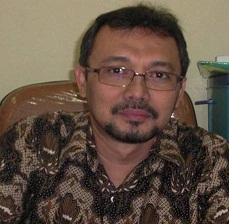Composition of Marine Debris on The Coast of Banyuwangi, East Java
Downloads
Marine debris has emerged as a significant environmental issue of growing global concern, closely linked to pollution and its impact on the environment. Understanding the distribution of marine waste in coastal areas is crucial, especially considering that beaches are key sites for various human activities such as tourism, fishing, and shipping. To address this, a study was conducted to analyze the composition of marine debris on three beaches in Banyuwangi Regency, East Java. The study took place in July and August of 2023, focusing on Boom, Cacalan, and Cemara beaches. Marine debris was collected along the coastline in 5 x 5 m transects, spaced 20 m apart, to identify and quantify the types of waste. The findings revealed that Boom Beach had the highest percentage of rubbish (46%), followed by Cemara Beach (30%) and Cacalan Beach (24%). Additionally, the highest abundance of rubbish per area was found at Boom Beach (5.97 ± 16.64 item/m2), Cemara Beach (3,92 ± 11,36 item/m2), and Cacalan Beach (3,12 ± 5,27 item/m2). Boom Beach and Cemara Beach were primarily dominated by plastic waste, while at Cacalan Beach, plastic waste and broken glass were found in nearly equal proportions. The calculation of the Clean Coast Index (CCI) indicated that all three beaches were significantly polluted. As a result, there is a clear need for focused attention on waste management at tourist beaches to preserve the aesthetics and comfort of beach visitors.
Aliviyanti, D., Kasitowati, R. D., Yona, D., Semedi, B., Rudianto, Asadi, M. A., Isdianto, A., & Dewi, C. S. U. (2022). Edukasi bahaya sampah plastik pada perairan dan biota laut di Sekolah Alam, Pantai Bajulmati, Kabupaten Malang, Jawa Timur. Abdi Geomedisain. 2(2):119-129. https://journals2.ums.ac.id/index.php/abdigeomedisains/article/view/408/158
Alkalay, R., Pasternak, G., & Zask, A. (2007). Clean-coast index-a new approach for beach cleanliness assessment. Ocean and Coastal Management, 50(5–6):352-362. https://doi.org/10.1016/j.ocecoaman.2006.10.002
Amalia, F. R., Wijayanti, T., & Rahayu, N. S. (2018). Pemetaan dan peningkatan kualitas layanan jasa wisata Pantai Cemara Banyuwangi. Journal of Tourism and Creativity, 2(2):178-189. https://jurnal.unej.ac.id/index.php/tourismjournal/article/view/13848
Araújo, M. C. B., Silva-Cavalcanti, J. S., & Costa, M. F. (2018). Anthropogenic litter on beaches with different levels of development and use: A snapshot of a coast in Pernambuco (Brazil). Frontiers in Marine Science, 5(233):1-10.
https://doi.org/10.3389/fmars.2018.00233
Farhani, N., & Nugroho, S. (Ed.). (2020). Pedoman pemantauan sampah laut. Jakarta: Kementerian Lingkungan Hidup dan Kehutanan.
Fauziah, S. H., Rizman-Idid, M., Cheah, W., Loh, K-H., Sharma, S., NoorMaiza, M. R., Bordt, M., Praphotjanaporn, T., Samah, A. A., Shamsuddin, J., & George, M. (2021). Marine debris in Malaysia: A review on the pollution intensity and mitigating measures. Marine Pollution Bulletin, 167(112258). https://doi.org/10.1016/j.marpolbul.2021.112258
Gall, S. C., & Thompson, R. C. (2015). The impact of debris on marine life. Marine Pollution Bulletin, 92(1–2):170-179. https://doi.org/10.1016/j.marpolbul.2014.12.041
Iñiguez, M. E., Conesa, J. A., & Fullana, A. (2016). Marine debris occurrence and treatment: A review. Renewable and Sustainable Energy Reviews, 64:394-402. https://doi.org/10.1016/j.rser.2016.06.031
Jambeck, J. R., Geyer, R., Wilcox, C., Siegler, T. R., Perryman, M., Andrady, A., Narayan, R., & Law, K. L. (2015). Plastic waste inputs from land into the ocean. Science, 347(6223):768-771. DOI:10.1126/science.1260352
Jangga, R. A. Q., Tallo, I., & Toruan, L. N. L. (2021). Komposisi sampah laut di pesisir pantai Kabupaten Malaka, Provinsi Nusa Tenggara Timur. Jurnal Bahari Padadak, 2(2):22-30.
Latifah, A. (2015). Prosiding Pengembangan Pariwisata yang Berkelanjutan: Inovasi, Teknologi dan Kearifan Lokal. March, 27. http://repository.unej.ac.id/bitstream/handle/123456789/65672/Ainul Latifah-101810401034.pdf?sequence=1
Law, K. L. (2017). Plastics in the marine environment. Annual Review of Marine Science, 9:205-229. https://doi.org/10.1146/annurev-marine-010816-060409
Nisak, R. Z. K., Nugraha, Y. A., Fajarsari, I. M., & Badian, M. S. R. (2023). Gerakan bersih pantai sebagai upaya mengurangi sampah di kawasan Pantai Kertosari Banyuwangi. Jurnal Pengabdian Masyarakat Bangsa, 1(10):2286-2291. https://doi.org/10.59837/jpmba.v1i10.506
Nurdin, A., Lidiawati, M., & Khairi, N. F. (2020). Pengaruh sampah organik, anorganik dan bahan berbahaya dan beracun (B3) terhadap pada pekerja di tempat pemrosesan akhir (TPA) Gampong Jawa Kota Banda Aceh. Jurnal Aceh Medika, 4(2):113-121. http://jurnal.abulyatama.ac.id/acehmedika
Patuwo, N. C., Pelle, W. E. P. E., Manengkey, H. W. K., Schaduw, J. N. W., Manembu, I., & Ngangi, E. L. A. (2020). Karakteristik sampah laut di Pantai Tumpaan Desa Tateli Dua Kecamatan Mandolang Kabupaten Minahasa. Jurnal Pesisir dan Laut Tropis, 8(1):70-83. https://doi.org/10.35800/jplt.8.1.2020.27493
Paulus, C. A., Soewarlan, L. C., & Ayubi, A. A. (2020). Distribution of marine debris in mangrove ecotourism area in Kupang, East Nusa Tenggara, Indonesia. AACL Bioflux, 13(5):2897-2909.
Putri, S. E. N., Yona, D., Setyawan, F. O., & Pangestuti, E. (2024). Analisis kualitas pantai berdasarkan keberadaan sampah di pantai wisata Bahak, Probolinggo. Jurnal Ilmu Lingkungan, 22(2):1009–1016.
Sagita, A., Sianggaputra, M. D., & Pratama, C. D. (2022). Analisis dampak sampah plastik di laut terhadap aktivitas nelayan skala kecil di Jakarta. Buletin Ilmiah Marina Sosial Ekonomi Kelautan dan Perikanan, 8(1):1-11. https://doi.org/10.15578/marina.v8i1.10731
Sakinah, W., Puspita, H. I. D., Rudianto, R., Saifurridzal, S., & Suyoso, G. E. J. (2022). Sosialisasi dan pelatihan pemanfaatan sampah organik sebagai eco-enzyme kepada wanita pesisir Pulau Santen, Banyuwangi. Journal of Community Development, 3(2):127-133. https://doi.org/10.47134/comdev.v3i2.87
Toruan, L. N. L., Tallo, I., & Saraswati, S. A. (2021). Sebaran sampah pantai di Pulau Timor, Nusa Tenggara Timur: Kajian pada pantai rekreasi. Jurnal Wilayah dan Lingkungan, 9(1):92-108. https://doi.org/10.14710/jwl.9.1.92-108
Tuahatu, J. W., & Tuhumury, N. C. (2022). Sampah laut yang terdampar di pesisir Pantai Hative Besar pada musim peralihan 1. Jurnal Triton, 18(1):47-54.
Ulana, L. K ; Agustin, R. D., & Darma, Y. Y. E. (2021). Aplikasi material komposit tahan api dalam pembuatan canoe flat bottom guna mendukung pemulihan ekonomi pasca pandemik di wahana air PantaiI Cacalan Kabupaten Banyuwangi. Prosiding Seminar Nasional Terapan Riset Inovatif (Sentrinov), 7(3):452-457.
Umilia, E., & Mahendra, D. (2022). Identifikasi faktor prioritas dan karakteristik wisata Pantai Boom Marina Banyuwangi di masa pandemi Covid-19. Jurnal Teknik ITS, 11(3):113-119. https://doi.org/10.12962/j23373539.v11i3.93941
van Gool, E., Campbell, M., Wallace, P., & Hewitt, C. L. (2021). Marine debris on New Zealand beaches—baseline data to evaluate regional variances. Frontiers in Environmental Science, 9(700415):1-9. https://doi.org/10.3389/fenvs.2021.700415
Yona, D., Nooraini, P., Putri, S. E. N., Sari, S. H. J., Lestariadi, R. A., & Amirudin, A. (2023). Spatial distribution and composition of marine litter on sandy beaches along the Indian Ocean coastline in the South Java region, Indonesia. Frontiers in Marine Science, 10(1220650):1-11. https://doi.org/10.3389/fmars.2023.1220650
Yona, D., Arifianti, D. N., Lestariadi, R. A., & Amirudin, A. (2024). Classification, composition, and sources of marine litter on beach sediment of Kondang Merak Coast, Malang, Indonesia. IOP Conference Series: Earth and Environmental Science, 1328(012015):1-7. https://iopscience.iop.org/article/10.1088/1755-1315/1328/1/012015/pdf
Yusra, Y., & Erlini, R. (2021). Komposisi dan kepadatan sampah laut (marine debris) Pantai Purus, Kota Padang. Jurnal Katalisator, 6(1):74-82.
http://doi.org/10.22216/jk.v5i2.5717http://ejournal.kopertis10.or.id/index.php/katalisator
Zahra, N. N. A., Dewanti, A. K., Yona, D., Aliviyanti, D., Dewi, C. S. U., & Yamindago, A. (2024). Analisis karakteristik sampah laut dan tingkat kebersihan di Pantai Sendang Biru dan Pelabuhan Perikanan Pondokdadap, Kabupaten Malang, Jawa Timur. Jurnal Ilmu Lingkungan, 22(4):852-860.
Copyright (c) 2024 Journal of Marine and Coastal Science

This work is licensed under a Creative Commons Attribution-NonCommercial-ShareAlike 4.0 International License.













